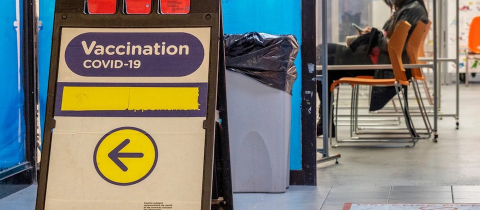Whatever the end result may be, the attack starts with the virus invading cells in the lining of the nose and throat. Here the virus can latch on to a protein known as “angiotensin converting enzyme 2 (ACE2)” found on the surface of the cells. From here it manages to worm its way into the cell. Once inside, the virus hijacks the cell’s genetic machinery and trick it into making copies of itself. These newly minted viruses then invade other cells and soon there is an army of viruses marching down the respiratory tract infecting whatever cells they encounter. The situation exacerbates when the virus reaches the cells that line the alveoli, tiny sacs in the lungs that inflate when air is inhaled and from which oxygen is transferred to the surrounding blood vessels. As the virus replicates inside these cells, the cell’s own life cycle is disrupted leading to its demise. This means the alveoli cease to function properly and tissues begin to be starved of oxygen.
However, the body doesn’t take this attack on its cells lying down. It begins to raise the temperature in an attempt to inactivate the virus and marshals the immune system into action, sending white blood cells into the battle. These recognize infected cells, engulf and digest them. They also release signaling molecules called cytokines that serve as a call for reinforcements. As the battle rages, more white blood cells rush to the scene. If enough of the infected cells are destroyed, the patient recovers. If the infection is not controlled, respiration increases in an attempt to compensate for the malfunctioning alveoli. There is a struggle for breath because the alveoli no longer inflate properly as they are filled with mucus and remnants of the digested infected cells. As a result, they cannot transfer oxygen to the blood, the lung tires from the struggle for breath, and a potentially fatal condition known as acute respiratory distress syndrome (AREDS) ensues. This is where intubation and ventilators enter the picture, pumping pressurized oxygen into the lungs, essentially breathing for the patient. Unfortunately, in the case COVID-19, the majority of intubated patients do not survive.
But shutting down respiration is not the only way that the SARS-CoV-2 virus can lead to disaster. The virus can also hone in on kidney cells since these are equipped with ACE2 receptors on their surface as well. Autopsies have detected tiny blood clots in tissues, so the virus even seems to affect blood coagulation, explaining why some patients suffer strokes or pulmonary embolism when blood vessels become clogged by clots. The fact that blood clots form is corroborated by high blood levels of “D-dimer,” a small protein that is released when a blood clot breaks down. The heart doesn’t escape attack either, although the mechanism by which it is damaged is not clear. Heart attacks have been documented in some COVID-19 patients with no preexisting cardiac problems. There are even ACE2 receptors in the digestive tract which is why some patients suffer from diarrhea and other gastrointestinal symptoms.
The scenario is further complicated by the possible damage to organs caused by an over-zealous immune system. This occurs when at first immune cells overestimate the danger, eject more cytokines than needed, bringing a horde of immune cells that, lacking appropriate targets, zero in on healthy tissues. This “cytokine storm” destroys healthy cells with possible catastrophic results. How can such a hyperimmune reaction be prevented?
One possibility that has emerged is the use of drugs that block cytokine receptors on immune cells, preventing them from receiving the “call for help.” One of these is tocilizumab that binds to receptors for interleukin-6 (IL-6), a cytokine that has been linked with inflammation. Some preliminary positive reports have led to the organization of trials that are now underway. Interleukin-1 is another cytokine that has been implicated in rheumatoid arthritis, a chronic inflammatory disease. Injections of anakinra, a drug that blocks IL-1 receptors have been used for the treatment of rheumatoid arthritis and are now being tried for COVID-19 in a number of countries. Another drug for rheumatoid arthritis, baricitinib, blocks enzymes that lead to the release of cytokines can also in theory be useful in COVID-19 and is being tried. Then we have the interesting case of “Specialized Pro-Resolving Mediators (SPM),” a class of molecules that are involved in dampening an immune reaction.
Our immune system is critical to maintaining health as it fights off infectious agents such as bacteria, viruses, and fungi. But once it has neutralized the invaders, it has to be reeled back to prevent the attack of healthy cells. Tissues around an infected area, fearing attack, send out chemicals to “resolve” the problem of being targeted for elimination by immune cells. These chemicals are the Specialized Pro-Resolving Mediators (SPM) whose specialty is to bind to specific receptors on immune cells and send the message “Whoa, you have done your job, now relax.”
There are four classes of these mediators known as lipoxins, resolvins, protectins, and maresins. All derive from essential fatty acids in our diet, mostly from omega-3 fats. Indeed, their role in modifying immune reactions is one of the reasons why these fats are termed “essential.” Besides viral infections, inflammation has been linked with all sorts of diseases such as arthritis, type-2 diabetes, asthma, arteriosclerosis, and cognitive decline, generating interest in the therapeutic use of specific SPMs. For example, a couple of metabolites of the omega-3 fats found in fish oils, such as 18-hydroxy-eicosapentaenoic acid (18-HEPE) and 17-hydroxy-docosahexaenoic acid (17-HDHA) have been identified as particularly active, and have even been formulated into dietary supplements. At this point, any suggestion that fish oils or their specific metabolites can be of use in the treatment of COVID-19 is unwarranted. But investigation into “Specialized Pro-Resolving Mediators” in conditions associated with a hyperimmune response may yield some jigsaw pieces that fit into the complex puzzle that is COVID-19.
Leave a comment!







